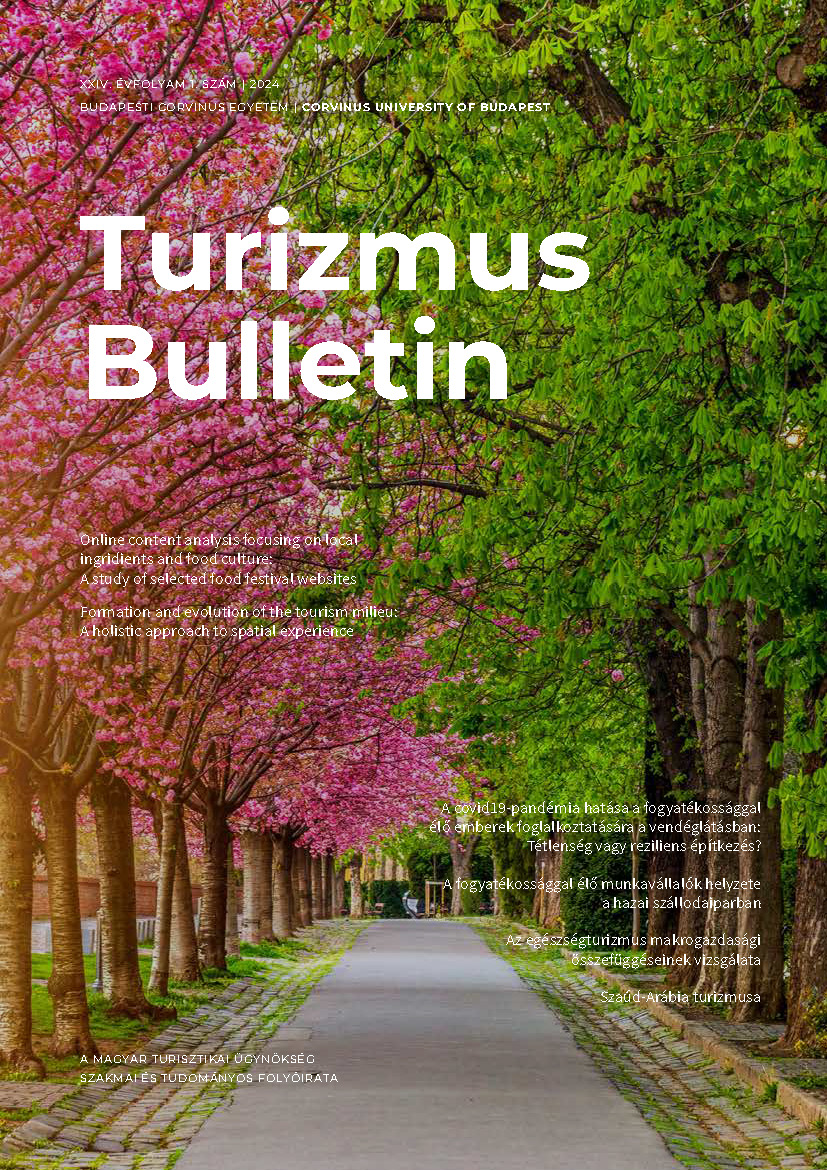A turisztikai miliő kialakulása és fejlődése: A térélmény holisztikus megközelítése
DOI:
https://doi.org/10.14267/TURBULL.2024v24n1.2Kulcsszavak:
turisztikai miliő, megtestesítés, észlelés, desztináció átalakulásaAbsztrakt
Ez a kutatás a turisztikai miliő kialakulását és fejlődését vizsgálja holisztikus filozófiai megközelítésben, amely integrálja Kant tudás alapjaira és Merleau-Ponty érzékeléssel és megtestesüléssel kapcsolatos nézeteit, hangsúlyozva az érvelés és a kritikai gondolkodás jelentőségét a turisztikai célállomások komplexitásának megértésében. A kutatás célja a turisták, a helyi lakosok és a környezetük közötti kölcsönhatások vizsgálata, rávilágítani a turizmus átalakító hatására, ezáltal értékes betekintést nyújtani a desztinációk fejlődésének bonyolult dinamikájába. A kutatás helyszíne a budapesti zsidó negyed, amely kulturális értékekben és városi dinamizmusban egyaránt gazdag. Az elméleti diskurzus és a pragmatikus elemzések szintézisén keresztül a tanulmány nemcsak a turisztikai miliő dinamikájának megértését segíti, hanem kiáll az ágazatot érintő fenntartható fejlődési gyakorlatok elfogadása mellett is.
Hivatkozások
BUTOWSKI, L. (2023): The ontological and epistemological foundations of tourism geography: chosen aspects of its empirical field of research. Geographia Polonica. 96(3). pp. 303–320. https://doi.org/10.7163/gpol.0257
HALL, S. (2021): Cultural Identity and Diaspora (1990). In: Gilroy, P. – Gilmore, R. (eds): Selected Writings on Race and Difference. Duke University Press, New York, USA.
HARRINGTON, J. T. (2004): Being here: heritage, belonging and place making. PhD thesis, James Cook University. Available at: https://researchonline.jcu.edu.au/71/4/04chapter3.pdf
HILL, C. S. (2022): Perceptual Phenomenology. In: Perceptual Experience. Oxford Academic, Oxford.
KANT, I. (1998): Critique of Pure Reason. Cambridge University Press, Cambridge.
KUMARI, P. – ANAND, A. – PRAVEEN, P. – VERMA, A. R. – GODIYAL, A. (2024): Infrastructure Potential and Human-Centric Strategies in the Context of Industry 5.0. In: Khan, M. – Khan, R. – Praveen, P. – Verma, A. – Panda, M. (eds): Infrastructure Possibilities and Human-Centered Approaches With Industry 5.0. IGI Global. pp. 199–214. https://doi.org/10.4018/979-8-3693-0782-3.ch012
LARSEN, S. C. – JOHNSON, J. T. (2012): Toward an open sense of place: phenomenology, affinity, and the question of being. Annals of the Association of American Geographers. 102(3). pp. 632–646.
MALPAS, J. E. (2008): Heidegger’s topology: Being, place, world. MA: MIT Press, Cambridge. MALPAS, J. E. (1999): Place and experience: A philosophical topography. Cambridge University Press, Cambridge. MASSEY, D. (2005): For space. Sage Publications, London.
MASSEY, D. (2004): Geographies of Responsibility. Geografiska Annaler. Series B, Human Geography. 86(1). Special Issue: the political challenge of relational space pp. 5–18.
MÉRAI, D. – KULIKOV, V. (2024): Ruin heritage and its reuse: the case of ruin bars in Budapest. Journal of Cultural Heritage Management and Sustainable Development. 14(1). pp. 15–32. https://doi.org/10.1108/JCHMSD-07-2022-0108
MERLEAU-PONTY, M. (2012): Phenomenology of Perception. Translated by Landes, D. A. Routledge. Available at: https://ia601000.us.archive. org/11/items/G.BachelardThePoeticsOfSpace/Phenomenology%20of%20Perception.pdf
MICHALKÓ, G. – BAL, D. – ERDÉLYI, É. (2022): Repositioning Budapest’s tourism milieu for a post-Covid-19 period: Visual content analysis. European Journal of Tourism Research. 32. 3204.
MICHALKÓ, G. – RÁTZ, T. (2008): The role of the tourist milieu in the social construction of the tourist experience. Journal of Hospitality Application and Research. 3(1). pp. 22–32.
MICHALKÓ, G. – RÁTZ, T. (2006): The Mediterranean tourist milieu. Anatolia: an International Journal of Tourism and Hospitality Research. 17(1). pp. 93–109.
PINKE-SZIVA, I. – SMITH, M. – OLT, G. – BEREZVAI, Z. (2019): Overtourism and the night-time economy: A case study of Budapest. International Journal of Tourism Cities. 5(1). pp. 1–16. https://doi.org/10.1108/IJTC-04-2018-0028
RANDVIIR, A. (2020): Space and place as substrates of culture. Place and Location. 2. pp. 140–154. Available at: https://nyydiskultuur.artun.ee/wp-content/uploads/2020/08/KP2_09randviir. pdf
ROGERS, A. J. – WEISLER, M. I. (2024): Terrestrial cultural landscapes changed inshore marine ecosystems: Eight centuries of shellfish harvesting from the Kawela Mound site, Hawaiian Islands. The Holocene. 0(0). https://doi.org/10.1177/09596836231219474
SMITH, M. – PINKE-SZIVA, I. – BEREZVAI, Z. – BUCZKOWSKA-GOŁĄBEK, K. (2022): The changing nature of the cultural tourist: Motivations, profiles and experiences of cultural tourists in Budapest. Journal of Tourism and Cultural Change. 20(1-2). pp. 1–19. https://doi.org/10.1080/14766825.2021.1898626
SMITH, M. – PINKE-SZIVA, I. – OLT, G. (2019): Overtourism and resident resistance in Budapest. Tourism Planning and Development. 16(4). pp. 376–392. DOI: 10.1080/21568316.2019.1595705
VIGIOLA, G. Q. (2022): Understanding place in place-based planning: from space- to people centred approaches. Land. 11(11). pp. 1–15. https://doi.org/10.3390/land11112000
ZÁTORI, A. – SMITH, M. (2014): The creative heart of Budapest. In: Marques, L. – Richards, G. (eds): Creative districts around the world: celebrating the 500th anniversary of Bairro Alto. NHTV University of Applied Sciences. pp. 105–110.

